An ordinary machine that rose to unusual heights.
Sounds crazy but I would love to hear the loud metal-on-metal screech of our old farm elevator. The din would whisk me back fifty years. Mom and Dad would be young, vital, strong, and we would smile, joke, and work together. That would be such a gift.
The elevator was just a piece of machinery for filling and emptying corncribs and granaries and loading bales into the haymow on our Essex County farm. Many of my memories revolve around using that huge grey and red conveyor on wheels. It was shared, along with other equipment and labour, with the other Roadhouses on the 7th Concession in Mersea Township.
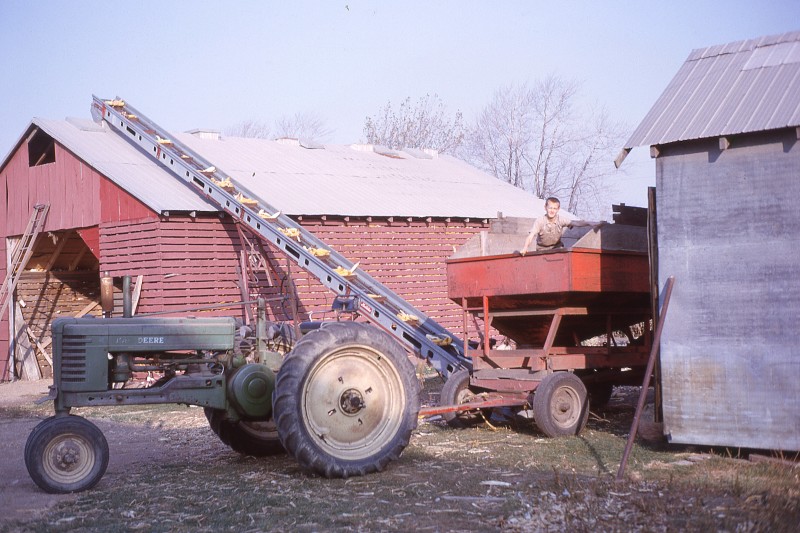
Ralph Roadhouse in wagon, loading corncrib, 1963-64. Photo by Walter Roadhouse.
Every October as my Dad harvested field corn with either a one or two-row corn picker, a continuous swap took place. Empty wagons were tractored to the field and full ones brought back to the farmyard where the elevator waited. Load after load of hard yellow corn-on-the-cob would be poured from wagons onto the elevator, and it methodically scraped them up, up, up to dump them inside. As the crib filled, the elevator and its accessories had to be moved again and again to the next access door in the roof.
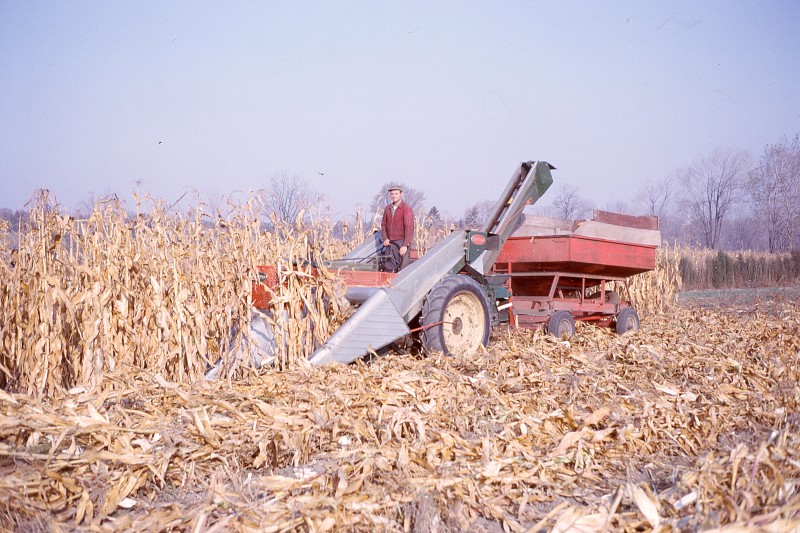
Uncle Stanley running the mounted two-row corn picker, 1963-64. Photo by Walter Roadhouse.
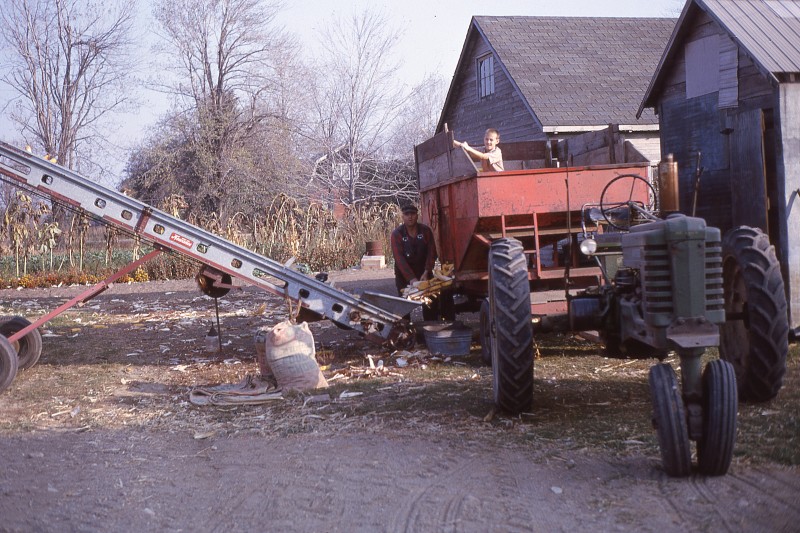
Roadhouse cousins, Ernie and Ralph, loading corncrib, 1963-64. Photo by Walter Roadhouse.
The huge task of emptying the cribs took place the following spring and summer when the corn prices were better. All those yellow ears had to be loaded back into wagons using the elevator. At first the corn poured out by itself from little doors at the bottom of the crib, then we climbed into the crib to kick it down, then finally we shovelled. The wagons filled slowly when we were down to one scoop at a time, so the elevator screeched on and on, harmonizing with the scrape of shovels on concrete. Any communication during that time was a shout in your ear or pantomime, which could be entertaining. When a wagon was finally full and the elevator stopped, our ears rang and vibrated in the sudden stillness.
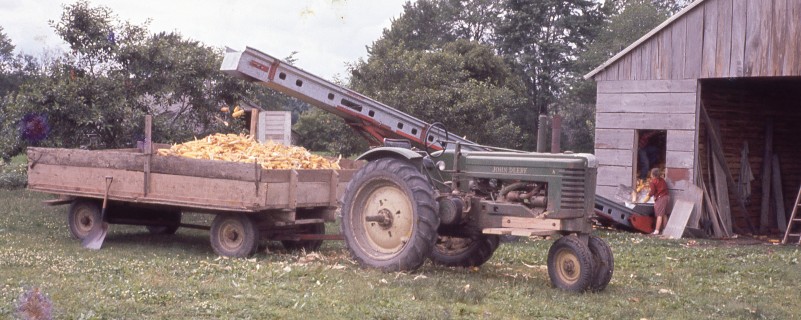
Pat unloading corncrib, 1963-64. Photo by Walter Roadhouse.
Because of all the livestock on the farm, the haymow had to be filled every year with hay and straw bales. The hay wagons were unloaded, one bale at a time, onto the elevator. The person unloading the wagon carefully spaced the bales according to the number of haymow workers and how far they walked to pile them. When the wagon was emptied, the crew often climbed down the elevator as the quickest route to the water jugs.
Part of the haymow was loaded through an opening high on the east side of the big barn. Moving the elevator across the entire farmyard to that door involved ducking under power lines. The elevator would be cranked down to its lowest setting then Dad hefted the bottom end of the elevator to steer it while we pushed at the wheels. When we reached the wire, Dad lifted his end high to make sure the top end didn’t touch the power line and electrocute us. This event always made me (the paranoid child) very nervous.
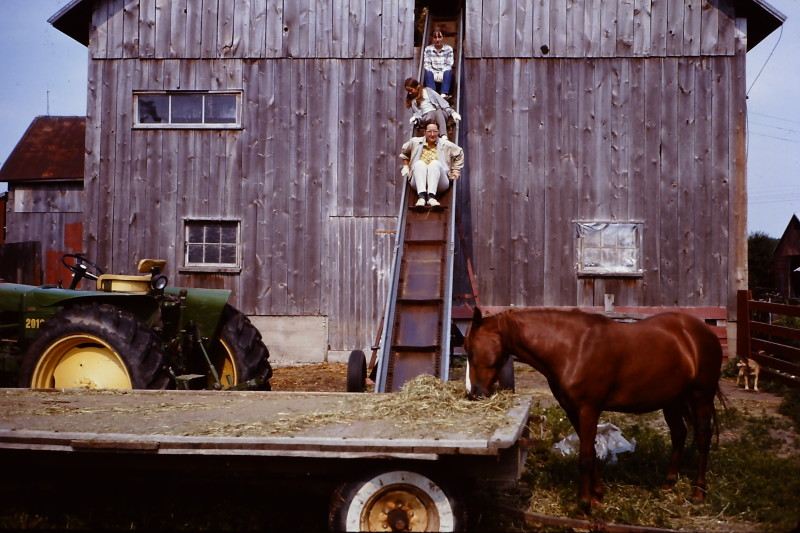
Grass hay now loaded into the east haymow, Ginger is taste-testing the product. Mom (Eleanor), Susan (the paranoid child looking over the edge), and Pat on the elevator, 1969. Photo by Walter Roadhouse.
That huge elevator always sat outside in our yard; no indoor storage space was big enough. And that bothered my Dad. Whenever it was humanly possible he stored his equipment inside. When my parents stopped raising two-hundred-pound pigs for market, the pole barn was available for equipment storage. Dad dismantled the four big pens and carefully parked most of the machinery inside. Packing equipment into the barn using the handy front end hitch on the John Deere B tractor allowed precision placement, like a game of Tetris. Dad dearly loved his jigsaw puzzles.
In the late 80’s when all the animals were gone and the corncribs unused, Dad took on the challenge of storing the elevator in the pole barn. We are guessing at how he accomplished the feat. He either took down part of a wall to get it in, or, he pushed and pulled the elevator left, scant inches at a time, until it was 90 degrees to the big entry door. To give an idea of the size, the barn was four sections wide and the elevator was three sections long. And keep in mind, it was a pole barn so it had big posts bracing the roof every fifteen feet. Once Dad had the elevator in the approximate location, he used chains and pulleys to support the body while he removed the undercarriage and wheels then winched the elevator higher and higher until it nestled against the roof trusses – totally out of the way and perfectly out of the weather. He had done it; he could relax.
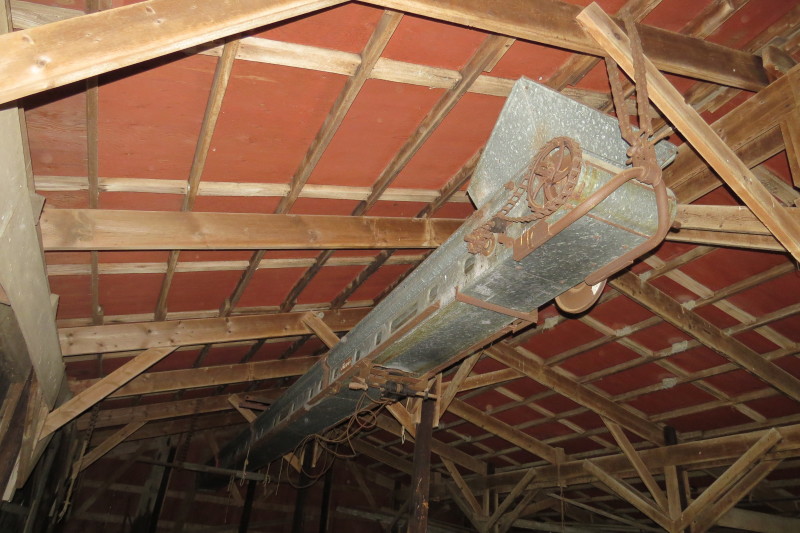
The old farm elevator, 2015. Photo by Cheryl Regnier.
Dad passed away twenty years ago now and gradually the jigsaw puzzle in the pole barn has been pulled apart except for the elevator. A variety of people walked around under it then stood looking up, scratching their heads.
“How the heck did he get it up there?”
“Won’t be easy to get down.”
“Maybe we should just leave it there; it’s not in the way.”
Amidst the baffled and exasperated musings I imagined my Dad. He would be chuckling in his quiet way with a wide smile on his face, looking down, scuffing his work boots, but enjoying tremendously the reaction to the puzzle he left behind.

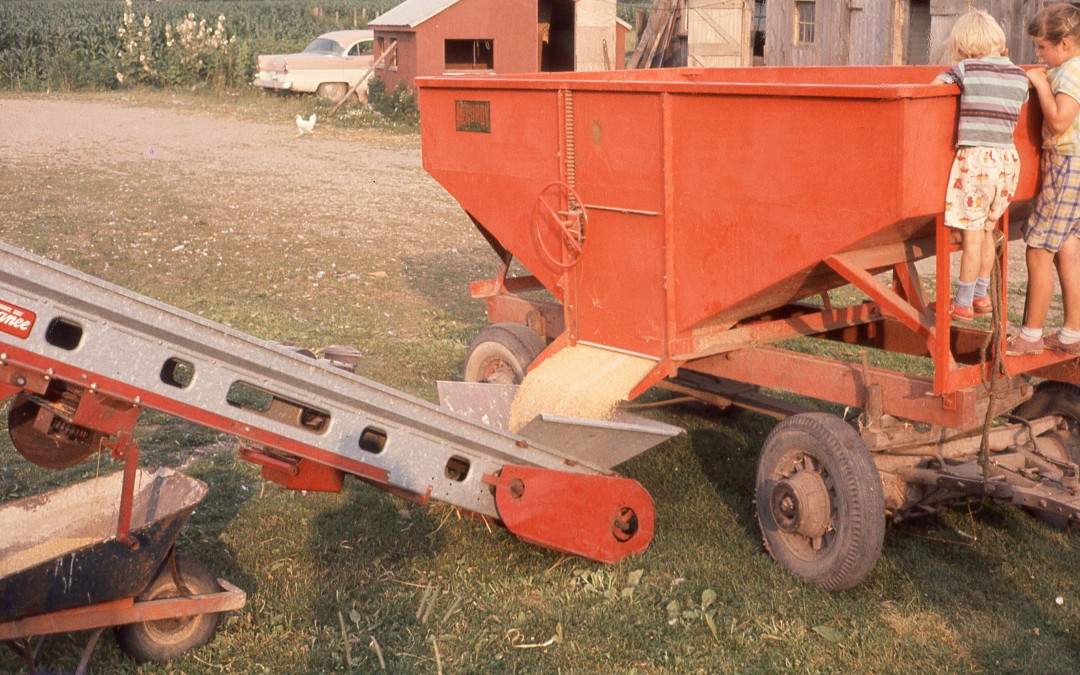

Another great story, Sue. Wonderful to have all those pictures.
Hi Jerry, I’m glad you enjoyed the story and the pictures! We are so lucky that Dad loved taking photographs. And Mom was good at pointing out photo opportunities!